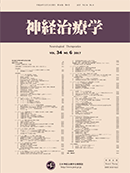Volume 33, Issue 3
Displaying 1-50 of 71 articles from this issue
-
2016 Volume 33 Issue 3 Pages 289-292
Published: 2016
Released on J-STAGE: November 10, 2016
Download PDF (370K) -
2016 Volume 33 Issue 3 Pages 293-295
Published: 2016
Released on J-STAGE: November 10, 2016
Download PDF (451K)
-
2016 Volume 33 Issue 3 Pages 297
Published: 2016
Released on J-STAGE: November 10, 2016
Download PDF (216K) -
2016 Volume 33 Issue 3 Pages 298
Published: 2016
Released on J-STAGE: November 10, 2016
Download PDF (219K) -
2016 Volume 33 Issue 3 Pages 299-302
Published: 2016
Released on J-STAGE: November 10, 2016
Download PDF (1459K) -
2016 Volume 33 Issue 3 Pages 303-306
Published: 2016
Released on J-STAGE: November 10, 2016
Download PDF (949K) -
2016 Volume 33 Issue 3 Pages 307-310
Published: 2016
Released on J-STAGE: November 10, 2016
Download PDF (404K) -
2016 Volume 33 Issue 3 Pages 311
Published: 2016
Released on J-STAGE: November 10, 2016
Download PDF (216K) -
2016 Volume 33 Issue 3 Pages 312
Published: 2016
Released on J-STAGE: November 10, 2016
Download PDF (202K)
-
2016 Volume 33 Issue 3 Pages 313-317
Published: 2016
Released on J-STAGE: November 10, 2016
Download PDF (1159K) -
2016 Volume 33 Issue 3 Pages 318-322
Published: 2016
Released on J-STAGE: November 10, 2016
Download PDF (3572K) -
2016 Volume 33 Issue 3 Pages 323-327
Published: 2016
Released on J-STAGE: November 10, 2016
Download PDF (449K) -
2016 Volume 33 Issue 3 Pages 328-331
Published: 2016
Released on J-STAGE: November 10, 2016
Download PDF (617K) -
2016 Volume 33 Issue 3 Pages 332
Published: 2016
Released on J-STAGE: November 10, 2016
Download PDF (195K) -
2016 Volume 33 Issue 3 Pages 333-337
Published: 2016
Released on J-STAGE: November 10, 2016
Download PDF (830K)
-
2016 Volume 33 Issue 3 Pages 338-342
Published: 2016
Released on J-STAGE: November 10, 2016
Download PDF (441K)
-
2016 Volume 33 Issue 3 Pages 343
Published: 2016
Released on J-STAGE: November 10, 2016
Download PDF (236K) -
2016 Volume 33 Issue 3 Pages 344-348
Published: 2016
Released on J-STAGE: November 10, 2016
Download PDF (2092K) -
2016 Volume 33 Issue 3 Pages 349-351
Published: 2016
Released on J-STAGE: November 10, 2016
Download PDF (421K) -
2016 Volume 33 Issue 3 Pages 352-356
Published: 2016
Released on J-STAGE: November 10, 2016
Download PDF (709K) -
2016 Volume 33 Issue 3 Pages 357-361
Published: 2016
Released on J-STAGE: November 10, 2016
Download PDF (1649K) -
2016 Volume 33 Issue 3 Pages 362-367
Published: 2016
Released on J-STAGE: November 10, 2016
Download PDF (1177K) -
2016 Volume 33 Issue 3 Pages 368-372
Published: 2016
Released on J-STAGE: November 10, 2016
Download PDF (811K) -
2016 Volume 33 Issue 3 Pages 373-377
Published: 2016
Released on J-STAGE: November 10, 2016
Download PDF (1646K) -
2016 Volume 33 Issue 3 Pages 378
Published: 2016
Released on J-STAGE: November 10, 2016
Download PDF (216K) -
2016 Volume 33 Issue 3 Pages 379
Published: 2016
Released on J-STAGE: November 10, 2016
Download PDF (205K) -
2016 Volume 33 Issue 3 Pages 380
Published: 2016
Released on J-STAGE: November 10, 2016
Download PDF (224K)
-
2016 Volume 33 Issue 3 Pages 381
Published: 2016
Released on J-STAGE: November 10, 2016
Download PDF (228K) -
2016 Volume 33 Issue 3 Pages 382-386
Published: 2016
Released on J-STAGE: November 10, 2016
Download PDF (1396K) -
2016 Volume 33 Issue 3 Pages 387
Published: 2016
Released on J-STAGE: November 10, 2016
Download PDF (167K) -
2016 Volume 33 Issue 3 Pages 388
Published: 2016
Released on J-STAGE: November 10, 2016
Download PDF (191K) -
2016 Volume 33 Issue 3 Pages 389-393
Published: 2016
Released on J-STAGE: November 10, 2016
Download PDF (1153K) -
2016 Volume 33 Issue 3 Pages 394
Published: 2016
Released on J-STAGE: November 10, 2016
Download PDF (229K)
-
2016 Volume 33 Issue 3 Pages 395
Published: 2016
Released on J-STAGE: November 10, 2016
Download PDF (277K) -
2016 Volume 33 Issue 3 Pages 396-398
Published: 2016
Released on J-STAGE: November 10, 2016
Download PDF (702K) -
2016 Volume 33 Issue 3 Pages 399-404
Published: 2016
Released on J-STAGE: November 10, 2016
Download PDF (1897K) -
2016 Volume 33 Issue 3 Pages 405
Published: 2016
Released on J-STAGE: November 10, 2016
Download PDF (208K)
-
2016 Volume 33 Issue 3 Pages 406
Published: 2016
Released on J-STAGE: November 10, 2016
Download PDF (238K) -
2016 Volume 33 Issue 3 Pages 407
Published: 2016
Released on J-STAGE: November 10, 2016
Download PDF (211K) -
2016 Volume 33 Issue 3 Pages 408
Published: 2016
Released on J-STAGE: November 10, 2016
Download PDF (215K) -
2016 Volume 33 Issue 3 Pages 409-412
Published: 2016
Released on J-STAGE: November 10, 2016
Download PDF (621K) -
2016 Volume 33 Issue 3 Pages 413
Published: 2016
Released on J-STAGE: November 10, 2016
Download PDF (165K)
-
2016 Volume 33 Issue 3 Pages 414
Published: 2016
Released on J-STAGE: November 10, 2016
Download PDF (218K) -
2016 Volume 33 Issue 3 Pages 415-419
Published: 2016
Released on J-STAGE: November 10, 2016
Download PDF (376K) -
2016 Volume 33 Issue 3 Pages 420-424
Published: 2016
Released on J-STAGE: November 10, 2016
Download PDF (2167K) -
2016 Volume 33 Issue 3 Pages 425-427
Published: 2016
Released on J-STAGE: November 10, 2016
Download PDF (720K) -
2016 Volume 33 Issue 3 Pages 428-432
Published: 2016
Released on J-STAGE: November 10, 2016
Download PDF (1063K)
-
2016 Volume 33 Issue 3 Pages 433-434
Published: 2016
Released on J-STAGE: November 10, 2016
Download PDF (940K) -
2016 Volume 33 Issue 3 Pages 435-438
Published: 2016
Released on J-STAGE: November 10, 2016
Download PDF (550K) -
2016 Volume 33 Issue 3 Pages 439
Published: 2016
Released on J-STAGE: November 10, 2016
Download PDF (237K)
